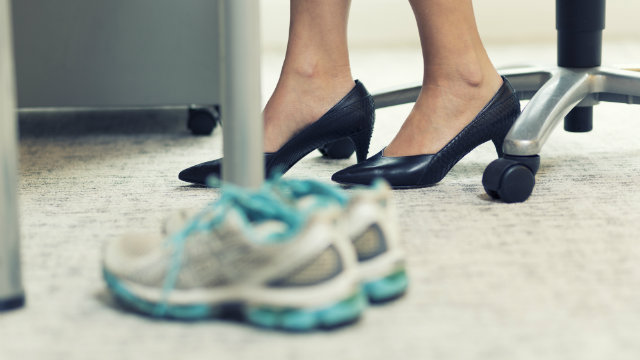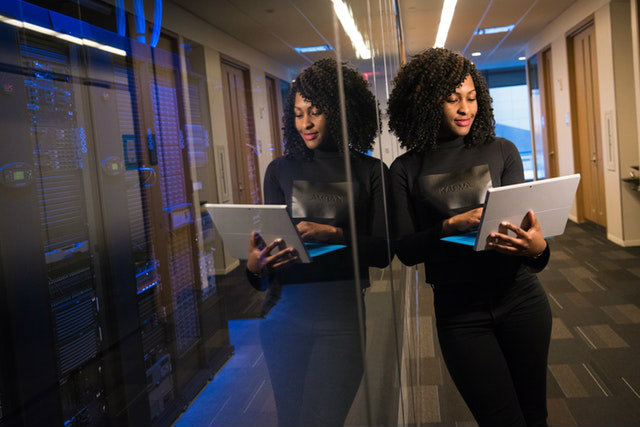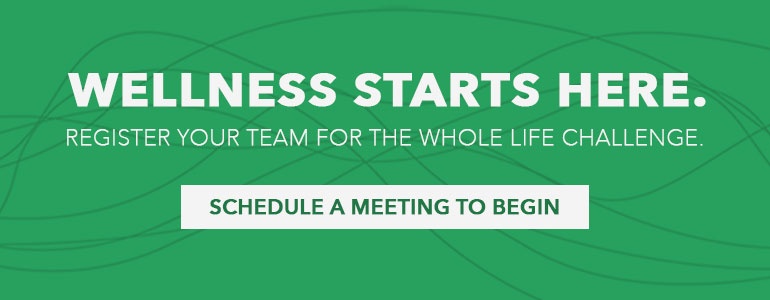I’m not going to lie. If I worked in a dress-code free zone, I would wear yoga pants and a sports tank under a suit jacket to office meetings. Heck, maybe with some nice cushy sneakers, I’d do quiet air squats in the back of the conference room instead of trying to sit still in swivel chairs. What’s the worst that could happen?
I realize society is not quite there yet in terms of accepting the importance of movement and exercise into office performance. In fact, many of us are losing precious sleep just to make sure we can exercise around our busy lives.
 Though fitness and work are not often friends, what if you could use one to better your performance at the other? What if instead of trying to be healthy around and despite our work, we could leverage the benefits of exercise to our advantage during our work day?
Though fitness and work are not often friends, what if you could use one to better your performance at the other? What if instead of trying to be healthy around and despite our work, we could leverage the benefits of exercise to our advantage during our work day?
Check out these five office exercise hacks that will increase not only your athletic efficacy, but also your ability to ace job tasks.
1. Reboot Your Work Wardrobe
To all my high-heeled homegirls and wingtip wonders, I feel your pain. Like…actual musculoskeletal pain. In 2016, a review of research on high heels found that wearing them caused an increased likelihood of bunions, injury to the shoe-wearer, and musculoskeletal pain to include the spine. As a flats-wearer, I can attest that shoes with no support are not much better.
It’s kind of silly if you think about it. Most of us spend upwards of $100 in the careful consideration of our workout sneakers every six months or so. These shoes get worn five hours a week on a good week. Then, for the shoes we spend forty-plus hours in, we pick something uncomfortable because they look impressive.
 Before you judge me, I consider myself to still be young and hip and I’m telling you if you cannot stand in your work shoes for thirty-minutes without pain, then you really are hurting yourself. Not to mention, the posture patterns you’re embedding into your biomechanics will follow you into the gym and continue to haunt you whether you’re running or lifting.
Before you judge me, I consider myself to still be young and hip and I’m telling you if you cannot stand in your work shoes for thirty-minutes without pain, then you really are hurting yourself. Not to mention, the posture patterns you’re embedding into your biomechanics will follow you into the gym and continue to haunt you whether you’re running or lifting.
Put Your Shoes to This Test: consider a shoe that you wouldn’t mind walking two miles in. Most of us will walk at least two miles within an office day, so why not plan ahead for it? And if you really can’t give up pointy-toed, tight-leather fashion, pick up a pair of sneakers to hide under your desk for relief.
2. Schedule Workouts Prior to the Hardest Part of Your Day
Working out is not just about biceps and six packs. A tremendous amount of research supports that exercise actually gives you brainpower. According to Harvard, researchers found that exercise can increase the size of your hippocampus, the part of the brain that is involved with verbal memory and learning.
As explained in the book Spark, researchers have also found that the timing of your aerobic activity can increase your ability to process and encode new information in the hours immediately following that exercise.
The Art of Exercise: if you’re planning for a mentally grueling office training or a negotiation with a difficult client, schedule these appointments as close to following an aerobic workout as possible. Any workout that gets your heart rate to at least 70% intensity for twenty minutes will do. Why not give yourself the edge of a readied mind from a strategic workout beforehand? Perhaps your competitor is already doing the same?
 3. Replace Afternoon Coffee with a Lunchtime Walk
3. Replace Afternoon Coffee with a Lunchtime Walk
Now that we are in the right footwear, and we know there is another tough meeting in the afternoon, what’s a deskbound office worker to do?
Not too long ago, I moved to a half-mile from my work so I could stop paying exorbitant urban dog-walker fees (perhaps a future retirement gig?). Little did I know there would be more gained for me in the long run — or should I say the long walk. Though this is a subjective, one-36-year-old-woman “study,” I will tell you that since I implemented walking home for lunch, I have yet to indulge in an afternoon coffee.
I’ve learned that afternoon coffee, in all its glory, has a trickle-down effect I’d rather live without. Caffeine late in the day (for me, after 2pm) keeps me from falling asleep on schedule, and then when I wake up, the first thing I want is more coffee.
Though standing up from your desk to “take a lap” outside the office building does not sell itself easily, once you do it, you’ll feel the energy difference. Increasing your heart rate by upping your oxygen demands even a little bit can whirl your body back into a productive mode.
Take It to the Next Level: athleisure-wear is on the rise. Stock up your wardrobe with pants you can move in and add twenty squats and a few flights of stairs in after your walk. Once you get back to your desk reinvigorated, your co-workers will be trying to figure out if there’s a sale on espresso somewhere.
4. Vary Your Work Position by Task
If you’ve ever sat on an airplane for more than an hour, you know the feeling of standing up and wishing you’d made a more deliberate effort to stroll the plane aisle a couple times. Yet, there we sit unmoving at our desks for hours on end, eating lunch by our keyboards and forgetting to stand until we finish the task at hand.
What if you trained yourself into a new ergonomic pattern? How about taking all phone calls standing? Printing reports at the furthest printer so you habitually take a walk when you’re finished working on something?
If your work day truly has no rhythm to it but a dull repetitive tone, maybe it’s best you set the rhythm yourself. Program a thirty-minute timer that alerts you to switch your body position. Ask for a sit-stand desk and aim for intervals of thirty-minutes sitting alternated with thirty-minutes standing.
A Few Tips for Your Hips: avoid crossing your legs, and if you must, then cross at the ankle and switch up your cross. Set up your chair height so your feet are planted on the ground, with the seat bottom at the height of the bottom of your knee-cap. When seated your knees should be at a ninety-degree angle.
 5. Mobilize at Your Desk
5. Mobilize at Your Desk
Why not mobilize while you work? Keep a golf ball and a tennis ball in your desk drawer and, when your work tasks allow, add those balls into your healthy work habits.
Golf Ball Foot Release:
- In a seated position, remove a shoe and use the golf ball to release the muscles and connective tissues in the soles of your feet.
- Think of the area between the heel and the ball of your foot as a rectangle.
- Applying pressure to the golf ball with your foot at an intensity that you would rate as less than painful, aim to have the golf ball essentially serve as a tiny “foam roller” traveling the perimeter of the rectangle.
- Stop at tension points and hold for an extra 30 seconds. Switch directions.
- Kick off the other shoe and repeat.
Tennis Ball Leg and Back Massage:
- In a seated position, place the tennis ball where your hamstrings meet your glutes. Work to roll the bottom of your thigh over the tennis ball by rolling the arch of your foot away from the floor, and then returning it to the floor.
- Stop at tension points and hold for an extra 30 seconds
- In a seated position, press the tennis ball into the top corners of the glutes on either side, near where your belt sits on the outside of your hip. Press the ball into your chair back to massage the external rotators of the hip. Switch sides and take notes on the differences between sides.
- Remaining seated, roll the tennis ball on the low back muscles at either side of your spine. Work on smooth, relaxing breathing even when hitting tension spots.
Which of These Office Exercise Hacks Is for You?
With a little planning ahead, implementing even a few of these office exercise hacks could easily turn work and exercise into “frenemies” at a minimum. Make the most of your workouts and work days by balancing their benefits and readying yourself for your next trip to the gym.

